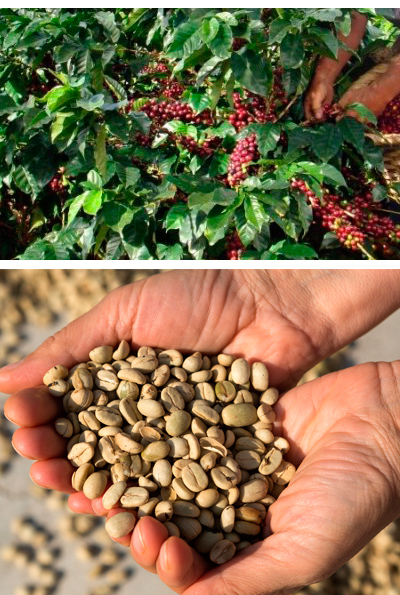The coffee
The plant
The coffee plant is an evergreen shrub of the Rubiacee family. Native to Abyssinia, a southern region of Ethiopia, it is cultivated in all tropical countries north and south of the equator. It has leaves similar to laurel leaves and small white scented flowers. The ripe fruit is a drupe that resembles a cherry because of its shape and the bright red colour of its skin; it contains the pulp and two green seeds, the coffee beans, wrapped in a thin protective membrane called parchment. Many are the species of coffee plants, but the most cultivated are Coffea arabica, native to Abyssinia, and Coffea robusta, native to Congo. About 70% of the coffee consumed in the world comes from the species Coffea arabica, which grows well in areas where the temperature is kept between 20 and 25 °C. The biggest plantations are in Brazil and Colombia, others in Central America, India and Indonesia, Equatorial Africa. The species Coffea robusta, so called because of its appearance and its greater resistance to climatic variations, is cultivated mainly in Indonesia, Brazil, West and Central Africa.

Coffee Harvesting Methods
The coffee plant blossoms and produces its fruits according to the fallen rainfall, which heavily affects the method of harvesting ripe cherries.
The two methods used are:
Picking: this method is the most expensive because it is done exclusively by hand. The ripe cherries are selected and then the pickers have to pass between the various rows several times a week;
Stripping: this method is more "violent" for the plant because it consists of holding a branch of the plant and then passing it forcefully between the fingers of the hand. In this way, a little bit of everything is collected: from ripe cherries, to unripe cherries, to rotten cherries, to the leaves of the plant. The quality of the harvest obtained with this method is lower than with picking.
Depending on whether you use one of the two methods you have repercussions on the final taste of the coffee: with picking the beans are all at the same level of ripeness, while with stripping the presence of coffee beans at a different level of ripeness risks giving worse results in the final product.
In fact, if unripe beans are present, the coffee will be more bitter and with an astringent taste.
The harvesting has been mechanized in some flat plantations, but the qualitative result is similar to stripping, with the addition of the risk of damage, even not light, to the plants.

Coffee bean processing
After harvesting, the ripe cherries, also known as drupes, cannot be eaten or transported. Before further processing, the shell must be removed from both grains.
Three types of procedure are valid: dry, semi-wet and wet. The type of procedure used depends on the water content and quality requirements. First of all, the outer film, the parchment and possibly also the silvery membrane are removed, as well as the water, so that only the clean and dry seed remains.
The "natural" (dry) processing method, the oldest one, involves drying the coffee cherries until the inner beans can be extracted without being damaged. The drupes are laid on dry cement or mechanically dried surfaces. The right degree of drying of the cherry is acquired when, shaking, the inner bean comes out. This method allows to produce a good coffee with pleasant body and aroma, very appreciated in the preparation of espresso.
The "semifinished" method involves the separation of the pulp and washing through a mechanical process using water. Without fermentation, the coffee bean is dried in the parchment from which it is then released mechanically.
Finally, the wet processing requires that the fresh and ripe cherries are separated from the pulp and impurities and then fermented in large tanks of water for 1-2 days. Wet processing is preferable to dry processing because it is faster and generally increases the acidity of the coffee. Washing is followed by drying.
The drying of the coffee must be slow. The water left in the bean is difficult to dry and therefore it is a long-lasting process. Natural drying requires the coffee to be deposited in areas exposed to the sun, in a position that facilitates the drainage of water. The coffee must be spread in thin layers and constantly rotated to accelerate the drying of water. Mechanical drying, on the other hand, is possible through various types of dryers which must be equipped with heat exchangers or gas burners. The dryers must be loaded with grains of equal moisture in order to obtain a more uniform drying process.

Roasting
The delicate roasting process makes a series of important changes to the coffee bean that transforms and becomes darker, lighter, fragile, larger, dry... and finally more aromatic.
Its change is profound and must take place in a uniform way, with a rapid passage of heat from one cell to another: its components, in fact, at high temperatures, undergo a transformation with the generation of new substances.
The roasting process lasts around 18/20 minutes with an air temperature of about 300° so that the coffee reaches about 215°, ending with air cooling. This solution requires more time and generates a greater weight loss of the coffee.
After roasting, a maturation process begins during which the carbon dioxide developed inside the bean escapes, causing the aromatic oleic substances to migrate towards the surface of the bean itself.
At this point it is really important not to let too much time pass from the date of production to the date of consume, keeping the product in beans away from light, heat, air and humidity in order to preserve all its qualities for an aromatic pleasure.